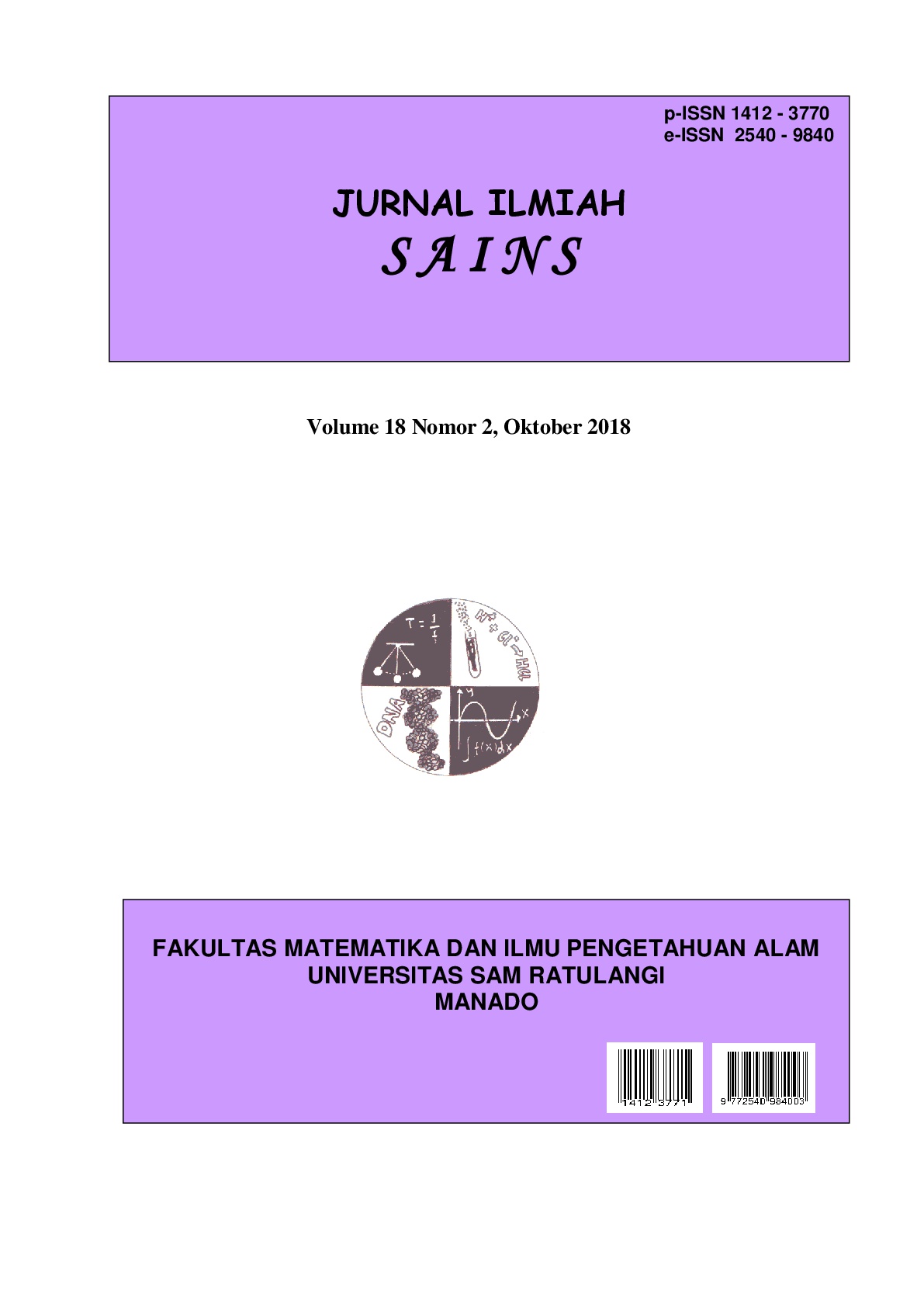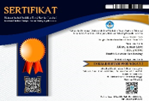STANDING-STOCK BIOMASS AND DIVERSITY OF Caulerpa (Chlorophyta) IN SOLONG-ON, SIQUIJOR ISLAND, PHILIPPINES
DOI:
https://doi.org/10.35799/jis.18.2.2018.20821Abstract
ABSTRAK
Spesies Caulerpa yang tumbuh di perairan dangkal sampai dilaut dalam dianggap sebagai gangguan ekonomi dan penting. Meskipun invasif di daerah beriklim sedang, spesies Caulerpa terutama C. racemosa dan C. lentillifera (lato) dipanen dan dikonsumsi sebagai makanan, terutama di Filipina. Komunitas Caulerpa di Solong-on, Siquijor adalah salah satu sumber untuk ekspor ke kota tetangga. Penelitian ini bertujuan untuk menentukan stok tegakan biomassa saat ini, prosentase dan keragaman Caulerpa di Solong-on, serta untuk menentukan parameter lingkungan yang dapat mempengaruhi kelimpahan dan keragamannya. Hasil penelitian menunjukkan total delapan spesies Caulerpa diidentifikasi di komunitas Caulerpa dangkal di Solong-on, Siquijor. Biomasa yang memiliki stok tertinggi diperoleh oleh C. cupressoides dengan biomassa rata-rata 26,16 ± 2,44 (SE) g berat kering/m-2, sedangkan C. microphysa memiliki biomassa stok yang berdiri paling sedikit dengan rata-rata 9,16 ± 0,26 g berat kering/m-2. Secara umum, total biomassa stok berdiri untuk semua spesies yang diperoleh selama periode sampling adalah 132,57 ± 2,06 g berat kering/m-2. Indeks keragaman Shannon-Wiener (H ') berkisar dari 1,7-2 yang menunjukkan komunitas Caulerpa yang relatif beragam. Analisis korespondensi kanonik (CCA) mengungkapkan bahwa suhu dan jenis substrat adalah pendorong utama biomassa Caulerpa.
Kata Kunci: biomassa, Caulerpa, tutupan, makroalga, parameter fisika-kimia
Â
ABSTRACT
Caulerpa species growing on shallow to deep waters are considered to be both economically nuisance and important. Although invasive in the temperate regions, Caulerpa species mainly C. racemosa and C. lentillifera (lato) are harvested and consumed as food, especially in the Philippines. Caulerpa communities in Solong-on, Siquijor are one of the sources for export to neighbouring municipalities. This study aimed to determine the present standing stock biomass, percent cover and diversity of Caulerpa in Solong-on, as well as to determine the environmental parameters that may affect its abundance and diversity. The results showed a total of eight species of Caulerpa were identified in the shallow Caulerpa community in Solong-on, Siquijor. The highest standing stock biomass was obtained by C. cupressoides with mean biomass of 26.16±2.44 (SE) g dry wt m-2, whereas C. microphysa has the least standing stock biomass with an average mean of 9.16±0.26 g dry wt m-2. In general, the total standing stock biomass for all species obtained throughout the sampling period was 132.57±2.06 g dry wt m-2. Shannon-Wiener diversity index (H') ranged from 1.7-2 suggesting a relatively diverse Caulerpa community. Canonical correspondence analysis (CCA) revealed that temperature and type of substrate were the main drivers of Caulerpa biomass.
Key Words: biomass, Caulerpa, cover, macroalgae, physic-chemical parameters
References
Aplikioti, M., Louizidou, P., Mystikou, A., Marcou, M., Stavrou, P., Kalogirou, S.,Tsiamis, K., Panayotidis, P., Küpper, F.C. 2016. Further expansion of the alien seaweed Caulerpa taxifolia var. distichophylla (Sonder) Verlaque, Huisman and Procacini (Ulvophyceae, Bryopsidales) in the Eastern Mediterranean Sea. Aquatic Invasions 11(1): 11–20.
Baldacconi, R., Corriero, G. 2009. Effects of the spread of the alga Caulerpa racemosa var. cylindracea on the sponge assemblage from coralligenous concretions of the Apulian coast (Ionian Sea, Italy). Marine Ecology 30:337–345.
Belton, G.S., Prud’homme van Reine, W.F., Huisman, J.M., Draisma, S.G.A., and Gurgel, C.F.D. 2014. Resolving phenotypic plasticity and species designation in the morphologically challenging Caulerpa racemosa-peltata complex (Caulerpaceae, Chlorophyta). Journal on Phycology 50: 32–54.
Belsher, T. and Meinesz, A. 1995. Deep-water dispersal of the tropical alga Caulerpa taxifolia introduced into the Mediterranean. Aquatic Botany 51: 163-169.
Boudouresque, C.F., Meinesz, A., Ribera, M.A., and Ballesteros, E. 1995. Spread of the green alga Caulerpa taxifolia (Caulerpales, Chlorophyta) in the Mediterranean: possible consequences of a major ecological event. Scientia Marina 59, supl.(1): 21-29.
Bouiadjra, B.B., Taleb, M.Z., Marouf, A., Benkada, M.Y., and Riadi, H. 2010. First record of the invasive alga Caulerpa racemosa (Caulerpales, Chlorophyta) in the Gulf of Arzew (western Algeria). Aquatic Invasions 5 supplement (1): S97-S101.
Calumpong, H.P. 1984. Abundance and Harvest of Caulerpa racemosa (lato) at Siquijor Island, Central Visayas, Philippines. Silliman Journal 31 (1-4): 46-52.
Cebrian, E. and Ballesteros, E. 2009. Temporal and spatial variability in shallow-and deep water populations of the invasive Caulerpa racemosa var. cylindracea in the Western Mediterranean. Estuarine, Coastal and Shelf Science (83): 469-474.
Ceccherelli, G. and Campo, D. 2002. Different Effects of Caulerpa racemosa on Two Co-occurring Seagrasses in the Mediterranean. Botanica Marina (45): 71-76.
Ceccherelli, G. and Piazzi, L. 2001. Dispersal of Caulerpa racemosa fragments in the Mediterranean: lack of detachment time effect on establishment. Botanica Marina (44): 209–213.
Cevik, C., Yokes, M.B., Cavas, L., Erkol, L.I., Dirici, O.B., and Verlaque, M. 2007. First report of Caulerpa taxifolia (Bryopsidales, Chlorophyta) on the Levantine coast (Turkey, Eastern Mediterranean). Estuarine, Coastal and Shelf Science (74): 549-556.
Cordero Jr., P.A. 1990. Philippine Algal Taxonomy: Past, Present, and Future. Culture and Use of Algae in Southeast Asia: 89-97.
Dean, A.J., Steneck, R.S., Tager, D., and Pandolfi, J.M. 2015. Distribution, abundance and diversity of crustose coralline algae on the Great Barrier Reef. Coral Reefs, doi: 10.1007/s00338-015-1263-5.
Delgado, O., Rodriguez-Prieto, C., Gacia, E., and Ballesteros, E. 1994. Nutrient-limited productivity of Caulerpa prolifera Agardh, an alien seaweed invading the North Western Mediterranean: Preliminary results. Proceedings of the 1st International Workshop on Caulepa prolifera GIS Posidonie, (CPGISP'94), Marseille: 295-299.
English, S., Wilkinson, C., and Baker, V. 1997. Survey Manual for Tropical Marine Resources 2nd Edition. Townsville, Australian Institute of Marine Science, 390p.
Fernández-GarcÃa, C., Cortés, J., Alvarado, J.J., and Nivia-Ruiz, J. 2012. Physical factors contributing to the benthic dominance of the alga Caulerpa sertularioides (Caulerpaceae, Chlorophyta) in the upwelling BahÃa Culebra, North Pacific of Costa Rica. Revista de BiologÃa Tropical 60: 93-107.
Gab-Alla, A.A.F.A. 2007. Ecological study on community of exotic invasive seaweed Caulerpa prolifera in Suez Canal and its associated macroinvertebrates. Journal of Applied Sciences 7: 679-686.
Gacia, E., RodrÃguez-Prieto, C., Delgado, O., and Ballesteros, E. 1996. Seasonal light and temperature responses of Caulerpa taxifolia from the northwestern Mediterranean. Aquatic Botany 53: 215-225.
Guiry, M.D., Guiry, G.M. 2018. Algae Base. World-wide electronic publication, National University of Ireland, Galway. http://www.algaebase.org; Accessed on 21 February 2018.
Hammer, Ø., Harper, D.A.T., Ryan, P.D. 2001. PAST: Paleontological Statistics software package for education and data analysis. Palaeontologia Electronica 9(1): 9.
Infantes, E., Terrados, J., Orfila, A. 2011. Assessment of substratum effect on the distribution of two invasive Caulerpa (Chlorophyta) species. Estuarine, Coastal and Shelf Science 9(1): 434-441.
IveÅa, L., Jaklin, A., Devescovi, M. 2006. Vegetation patterns and spontaneous regression of Caulerpa taxifolia (Vahl) C. Agardh in Malinska (Northern Adriatic, Croatia). Aquatic Botany 8(5): 324–330.
Jousson, O., Pawlowski, J., Zaninetti, L., Meinesz, A., Boudouresque, C.F. 1998. Molecular evidence for the aquarium origin of the green alga Caulerpa taxifolia introduced to the Mediterranean Sea. Marine Ecology Progress Series 172: 275-280.
Katsanevakis, S., Salomidi, M., Panou, A. 2010. Modelling distribution patterns and habitat preference of the invasive green alga Caulerpa racemosa in the Saronikos Gulf (Eastern Mediterranean). Aquatic Biology 10: 57-67.
Klein, J., Verlaque, M. 2008. The Caulerpa racemosa invasion: A critical review. Marine Pollution Bulletin 56: 205–225.
Kokabi, M., Yousefzadi, M., Razaghi, M., Feghhi, M.A. 2016. Zonation patterns, composition and diversity of macroalgal communities in the eastern coasts of Qeshm Island, Persian Gulf, Iran. Marine Biodiversity Records 9: 1-11.
Manas, H.M., Deshmukhe, G., Venkateshwarlu, G., Chakraborty, S.K., Jaiswar, A.K., Pankajkumar, Mugaonkar, H., Dar, S.A. 2015. Morpological comparison of different Caulerpa J.V. Lamouroux species along Maharashtra and Gujarat coast, India. Indian Journal of Geo-Marine Sciences 44(5): 732-737.
Mendoza, A.B. Jr. Soliman V.S. 2013. Community Structure of Macroalgae of Lagonoy Gulf, Bicol Region, Philippines. Kuroshio Science 7: 49-57.
Meñez, E.G., Calumpong, H.P. 1982. The Genus Caulerpa from Central Visayas, Philippines. City of Washington, Smithsonian Institution Press: 1-21.
Mueller-Dombois, D., Ellenberg, H. 1974. Aims and Methods of Vegetation Ecology. United States of America, John Wiley and Sons, Inc.
Nagappan, T. Vairappan, C.S. 2013. Nutritional and bioactive properties of three edible species of green algae, genus Caulerpa (Caulerpaceae). Journal of Applied Phycology 26: 1019–1027.
Papini, A., Mosti, S., Santosuosso, U. 2013. Tracking the origin of the invading Caulerpa (Caulerpales, Chlorophyta) with Geographic Profiling, a criminological technique for a killer alga. Biological Invasions, doi:10.1007/s10530-012-0396-5.
Piazzi, L., Balata, D., Foresi, L., Cristaudo, C., Cinelli, F. 2007. Sediment as a constituent of Mediterranean benthic communities dominated by Caulerpa racemosa var. cylindracea. Scientia Marina 71(1): 129-135.
Pinna, S., Bulleri, F., Mura, F., Sechi, N., Ceccccherelllli, G. 2011. Investigating on The Factors Responsible for Caulerpa racemosa Invasion. Biologia Marina Mediterranea. 18 (1): 280-281.
Prathep, A., Pongparadon, S., Darakrai, A., Wichachucherd, B., Sinutok, S. 2011 Diversity and distribution of seaweed at Khanom-Mu Ko Thale Tai National Park, Nakhon Si Thammarat Province, Thailand. Songklanakarin Journal of Science and Technology 33(6): 633-640.
RStudio Team. 2015. RStudio: Integrated Development for R. RStudio, Inc., Boston, MA URL http://www.rstudio.com/.
Ruiz, J.M., MarÃn-Guirao, L., Bernardeau–Esteller, J., Ramos–Segura, A., GarcÃa-Muñoz, R., Sandoval–Gil, J.M. 2011. Spread of the invasive alga Caulerpa racemosa var. cylindracea (Caulerpales, Chlorophyta) along the Mediterranean coast of the Murcia region (SE Spain). Animal Biodiversity and Conservation 34(1): 73-82.
Sahayaraj, K., Rajesh, S., Asha, A., Rathi, J.M., Raja P. 2014. Distribution and diversity assessment of the macroalgae at four southern districts of Tamil Nadu, India. Indian Journal of Geo-Marine Sciences 43(4): 607-617.
Schembri, P.J., Barbara, J., Deidun, A., Lanfranco, E., Lanfranco, S. 2015. It was only a matter of time: occurrence of Caulerpa taxifolia (Vahl) C. Agardh var. distichophylla (Sonder) Verlaque, Huisman and Procaccini in the Maltese Islands (Chlorophyta, Ulvophyceae, Caulerpaceae). BioInvasions Records 4(1): 9–16.
Short, F.T., Coles, R.G. 2001. Global Seagrass Research Methods. Volume 33 of Developments in Aquaculture and Fisheries Science(362 of Jackson Estuarine Laboratory contribution.
Taft, R.A., Jones, C. 2001. Sediment Sampling Guide and Methodologies (2nd Edition). Columbus, Ohio, Environmental Protection Agency.
ter Braak, C.J.F. 1986. Canonical Correspondence Analysis: A New Eigenvector Technique for Multivariate Direct Gradient Analysis. Ecology 67(5): 1167-1179.
ter Braak, C.J.F., Verdonschot, P.F.M. 1995. Canonical correspondence analysis and related multivariate methods in aquatic ecology. Aquatic Sciences 57: 255-289.
Terrados, J. Ros, J.D. 1995. Temporal variation of the biomass and structure of Caulerpa prolifera (Forsskål) Lamouroux meadows in the Mar Menor lagoon (SE Spain). Scientia Marina 59(1): 49-56.
Thibaut, T., Meinesz, A., Coquillard, P. 2004. Biomass seasonality of Caulerpa taxifolia in the Mediterranean Sea. Journal of Aquatic Botany 80): 291-297.
Tribollet, A.D. Vroom, P.S. 2007. Temporal and spatial comparison of the relative abundance of macroalgae across the Mariana Archipelago between 2003 and 2005. Phycologia 46 (2): 187–197.
Trono, G.C. 1997. Field guide and atlas of the seaweed resources of the Philippines. Makati City, Philippines, 306p.
U.S. Army Corps of Engineers Jacksonville District .2009. Quality Assurance Systems Requirements. Retrieved from http://www.tidalmarshmonitoring.org/pdf/1_CERP2009_SoilSedimentSampling_Chap07.pdf.
Verlaque, M., Afonso-Carrillo, J., Gil-RodrÃguez, M.C., Durand, C., Boudouresque, C.F., Le Parco, Y. 2004. Blitzkrieg in a marine invasion: Caulerpa racemosa var. cylindracea (Bryopsidales, Chlorophyta) reaches the Canary Islands (north-east Atlantic). Biological Invasions 6): 269–281.
Wagey, B.T., Bucol, A.A. 2014. A Brief Note of Lato (Caulerpa racemosa) Harvest at Solong-on, Siquijor, Philippines. Budidaya Perairan Januari 2(1): 46-51.
Williams, S.L. 1984. Uptake of sediment ammonium and translocation in a marine green macroalga Caulerpa cupressoides. Limnol. Oceanogr. 29(2): 374-379.







